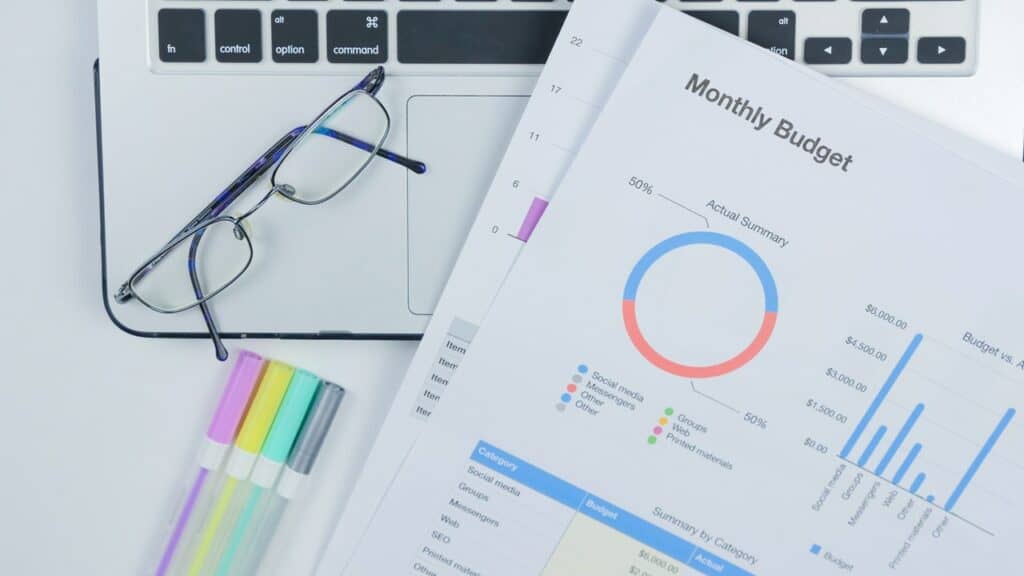
Budgets. Some love them, many avoid them.
We can safely say no one started an agency or business just for the excuse of creating and maintaining a budget. You started because you had a passion for your niche and saw opportunities. Over time your agency grew, so you took on more clients. Profits went up! But so did expenses.
In an agency’s early days, many wing it, relying on their gut. There are so many little things to take care of, there’s no time to stop and analyze. You pay bills as they come up and keep pressing forward, unaware of a growing monster taking shape in the shadows.
Eventually, it’s time as the agency owner to get a grip on your finances. This means facing the dreaded budget. But don’t worry, it’s not horrible.
In this blog post, we’ll help you understand:
- Why a budget is so important
- How to build a budget
- How to use a budget to monitor your progress
Why Should You Budget?
If budgets aren’t your thing, it helps to reframe how you think about them. Instead of thinking of a budget as a set of rigid guidelines and numbers, think about the information you’ll get. Also, don’t think of them as dull. Budget forecasting is part of dreaming and looking forward for the company. You’re shifting to think about your agency like a CFO. This mindset helps you use data to make better decisions about the future.
Budgets help us avoid landmines. If you’re only using your gut and looking behind you at last month’s financial reports to see if you made money, you’ll wander right into a minefield. Would you jump onto a plane with a pilot who doesn’t know where he’s going or how much fuel he has? I’d hope not.
A budget is just a beginning plan. It simply lets you know are you on track or off track? That’s it. This knowledge gives you confidence.

Before you Start your Budget, Consider Where you’re At
Everyone’s at a different stage, and it’s essential to know which of the stages you’re in:
- Cash burn
- Neutral (Break-Even)
- Building Reserve
- Strategic Investments and Risk-Taking
Some need to do something ASAP. If you’re in the cash burn stage, you’re burning through cash and need to correct things before losing too much money, but you still have the belief you can make things work.
Others are in more of a neutral or break-even phase. Most months, you have enough revenue coming in and expenses going out to start to feel comfortable. Most importantly, you’re able to pay all the bills!
Next comes building reserve. Finally, you’ve started to accumulate some cash. Most months, you have more revenue than expenses, maybe not every month, but you’re on an upward trajectory.
The final stage is where things get really fun. This is where you’ve figured your business out, the agency is doing well, and now it’s time to understand what to do with the cash. Of course, this is where we all hope to be!
Wherever you’re at is OK. There’s no right or wrong at this stage. You just need to be honest with where you’re at before beginning your budget.
A Little More About Break-Even
If you’re new to budgeting or in the earlier stages of your business, you must know your break-even point. This is how much sales you MUST have every month.
Break-even just means you’re not burning through cash.
Start simple. How much money do you need to cover all your business expenses? Many start their company and get moving without really thinking about this. They jump in and get focused on making more and more money without analyzing where they’re at.
Sit down and review the past 3-months of your expenditures. What are your cost of sales, operating expenses? How much business do you have? If after you’ve subtracted all your expenses from your sales, you have a negative, you’re not at break-even yet. But don’t worry. Budgeting is about finding these things out so you can take appropriate steps. You can plan how to get more sales or squeeze your expenses a bit more so you can reach your break-even point.

How to Build a Budget
Look to the past to forecast your future.
Start by looking over your last 12 months. Take a big-picture look over the monthly profit and loss statements over the previous year. Think about the year coming up. Can you replicate what you did last year? Then take all those figures and place them into a spreadsheet. Yeah, we know. Spreadsheets. But we’ll start you off with a readymade one to take the pain out of it.
Total up the numbers from the past year and ask yourself what changed over the year? Poke holes into every area, trying to find out what’s going on. A lot can change in a year – your customers, revenue, and circumstances. Consider all these factors to make tweaks to your expectations. Say you rolled out a new product and things are going well, factor that into next year, and plan how you can keep that momentum growing.
But don’t just think about the positive changes. What if this increase in new revenue from the new product rollout increases your operations costs? Often in the excitement of more money coming in, we won’t realize that the expenses have climbed.
You don’t have to be perfect at budgeting and forecasting. It’s not something you learn overnight. Just go through things step by step, using as much information as you can at the time. As you do this more, you’ll learn the factors that most impact your business.
A few areas to explore more:
Consider Your Costs
- Headcount increase/decrease
- Raises and bonuses
- Insurance premium increase
- Infrastructure increase (hosting, software, equipment upgrades, etc.)
Did anyone on your team perform exceptionally well last year? Are they up for a raise? Insurance costs will rarely go down in your life and will almost certainly rise every year. Have you factored that change in? What areas of the business need to improve in the coming months? If you don’t plan ahead, these items sneak up on us and become urgent. Leaving you to scramble to find cash. Budgets help us avoid these moments of financial panic.

Review Your Past Revenue Trends
Look over your past year’s finances to find large or disruptive recurring trends such as:
- Known/expected variances (do you always take a month off in the winter for a family trip?)
- Seasonal trends (do you do more business in the Summer?)
- Specific clients and/or projects
Do you do the same volume of sales throughout the year? Maybe you’re on a subscription model and know who’s going to pay when. Or are you seasonal, doing most of your revenue in certain months? Establish the patterns of when cash comes into your business and use those to build your budgeting decisions.
Be careful here. Just because you did $120K in revenue last year doesn’t mean you made $10K every month. When we know about the flow of our seasons, we can plan accordingly. The low months won’t surprise us and leave us scrambling for cash.
Current/Future Revenue Considerations
Know your marketing pipeline and conversion percentage:
- Leads
- Opportunities
- Proposals
What are conversions looking like right now? How consistently are leads converting to customers? Suppose you ARE doing a better job this year than last year. In that case, you’ll have more revenue but also more operational costs to support that revenue. Have you planned for these changes?
External Factors to Consider
- Clients
- Competition
- Industry
- Web
- Economic
We’ll never be able to know every single thing that’s going to happen. But that shouldn’t stop us from doing a little planning. When you think about external factors, pay particular attention to what’s going on in the areas immediately surrounding your industry. For example, if you service clients, is their industry being impacted. Are you an agency that mainly services the hospitality industry? Is something happening that would slow down tourism? If that client is slowing down, you need to consider what that means for your business.
Don’t think that all external factors are adverse events too. Say there’s a sudden spike in demand for home repairs. That also means there’s an influx in demand for home repair supplies. Will that increase in the need for home supplies cause an increase in their prices?
There are only a few ways to change cash flow – price changes, new sales, upselling to existing clients, cutting costs, and reduce time to collect on accounts.

Why Should You Budget?
Prepare for the worst but hope for the best
Be conservative.
When you lay out your budget and begin monitoring it, don’t fall into the trap of looking at your finances through rose-colored glasses. It’s good to be excited about potential sales, but be conservative in how much you estimate they will bring in. Being overly optimistic in your forecasting can lead you to spend money you don’t have in the future.
Ongoing Review and Forecasting
Budgeting is not a one-time activity. It’s not enough to have a plan sitting in a file somewhere. You have to use your budget. Every month take it out and try to tweak your budget. Bit by bit, month by month. You’ll see it gets a little better, a little more accurate each time. Were we off from our estimate? If so, why? And then how will we tweak the budget moving forward armed with that information? Once we know data and facts, we can make changes to that budget moving forward.
Once you have the last year laid out in front of you, patterns emerge. You get a view of what was happening when and then you think why? Why did sales drop there? Can I change that? These questions with the bigger picture will help us forecast the following year.
Constantly Monitor and Measure Your KPIs
KPI’s. You can have hundreds of key performance indicators, but what are the big important ones for your business? Start at the top level, then drill down as appropriate. Don’t lose sight of the big picture. It’s easy to get lost in the data, but you need to come back and look at the bigger picture. Narrow it down, focus on your specific business in your particular industry.
When you measure something. If it is 10% positive or negative and you’re not doing anything differently, you’re measuring the wrong thing. If you’re not taken action based on a measurement, then it’s not valuable to you.

Start Now, Get Better Over Time
Don’t wait for the perfect moment to begin budgeting. ANY budget is better than no budget.
Take time every month to review, learn and amend. You’ll learn and refine more every month. Soon, budgeting won’t be so boring or scary. It’s a continuous process.
Embrace the spirit of Kaizen – the Japanese belief in constantly improving the little details in your business.
Lastly, if you’re in an early stage and don’t understand all the concepts, terminologies, etc., be vulnerable enough to get help from others. Have the courage to raise your hand and say I don’t understand what you’re saying. Can you please help me? There’s a great community on our Digital Agency Owners Group on Facebook that will be happy to answer your questions.
Our good friend, Jeff Meziere – Virtual CFO, Co-founder and CFO of the Business Value Academy and CPA, would love to help you too.
This blog post is a summary of the July 7th, 2021 webinar hosted by Jeff Meziere.
Whatever you do, don’t let the fear of what you’ll discover stop you from starting the process. It’s only scary at the start. And then, little by little, it gets easier and better every day.





